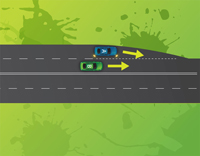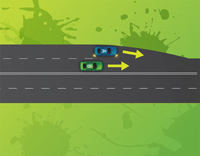Future Learners Need to Brush Up on High-Speed Manoeuvres
Categories: Driving News
Increasingly, the Government is taking more steps to protect drivers under 25. From next year (2014), testers will be prioritising the safe performance of ‘high-risk’ manoeuvres in driving tests, such as high-speed merging and turning across traffic. This adds to the other under-25 rules, such as logging 100-hours of supervised driving experience before taking the practical driving test and limiting the number of passengers a P1 driver can take between 11pm and 5am to just one.
There is already a ban on young drivers using high-powered vehicles, and this is yet another step to ensure young people can drive well on our busy roads. All these measures will hopefully aid to curtail the fatality rate in this age group, which is twice that of drivers over 25.
Reverse parking and hill starts will no longer be the main bugbears to master, as they shift down the priority list.
Northside Driver Training believes that high-speed merging into lanes is one of the key aspects to practice in driving lessons and supervised driving. This is because nervous drivers often slow right down while merging, perhaps unsure if others will give way, and may become a hazard to others if hesitant on a busy highway.
Passing your drivers test will become even trickier next year. “About two thirds of the 110,000 tests held in Queensland each year currently score a pass mark, but that is predicted to fall as more novice drivers face rejection under the tougher test”, The Courier Mail reports.
Tip: How to Merge Safely
What is the rule about merging lanes? It depends on if the lane is marked.
On roads where there are lanes marked on the road, if your lane comes to an end, you must give way to traffic already in the lane you are moving to. (See Image 1, TMR, Qld).
Tip from Department of Transport and Main Roads: When entering a motorway, look for a gap between the vehicles in the closest lane and safely build up speed on the on-ramp, so you enter at the traffic’s speed.
But, on roads where there are no lanes marked on the road, when lines of traffic merge, you must give way to any vehicle that is ahead of you. (See Image 2, TMR, Qld)
While it is common courtesy to allow a driver into the lane if their own lane ends, it’s always better to take the defensive position on the road.



Comments are closed.